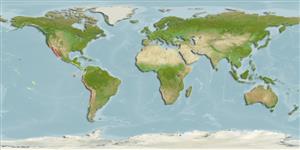Actinopterygii (strålfeniga fiskar) >
Perciformes (Perch-likes) >
Gobiidae (Gobies) > Gobiinae
Etymology: Lythrypnus: Greek, lythros, -on = blood + Greek, hypnos = sleep (Ref. 45335).
Miljö / Klimat / Range
Ekologi
; marina bottenlevande; djupintervall 0 - 76 m (Ref. 2850). Subtropical; 18°C - 22°C (Ref. 27115), preferred ?
Eastern Pacific: Gulf of California to Ecuador and north of Perú.
Size / Vikt / Age
Maturity: Lm ? range ? - ? cm
Max length : 6.4 cm TL hane/ej könsbestämd; (Ref. 2850)
Found usually in open rocky areas but retreats to crevices or holes or hides among spines of sea urchins when threatened. Territorial. Sits on exposed rock surfaces near a hole or crevice. Feeds mainly on small crustaceans. Oviparous (Ref. 56079). Males guard the eggs which are found attached to the walls of brood chamber (Ref. 56079). Female deposits oblong eggs in empty shells; male guards them. Often found with Lythrypnus zebra.
Life cycle and mating behavior
Könsmognad | Reproduktion | Lek | Ägg | Fecundity | Larver
Oviparous, demersal spawner (Ref. 101194). Both male and female spawn with many individuals in small contiguous territories (Ref. 240). Males guard the eggs which are found attached to the walls of brood chamber (Ref. 56079). Simultaneous hermaphrodite with varying allocation of reproductive tissue to male and female function (Ref. 31569). Bi-directional sex change has been confirmed for this species (Ref. 103751).
Eschmeyer, W.N., E.S. Herald and H. Hammann, 1983. A field guide to Pacific coast fishes of North America. Boston (MA, USA): Houghton Mifflin Company. xii+336 p. (Ref. 2850)
IUCN Red List Status (Ref. 115185)
CITES (Ref. 94142)
Not Evaluated
Threat to humans
Harmless
Human uses
Akvarium: Kommersiell
Ytterligare information
referenserVattenbrukVattenbruksprofilAvelslinjerGenetikAllelfrekvenserÄrftlighetSjukdomarBehandlingMass conversion
Verktyg
Special reports
Download XML
Internet-källor
